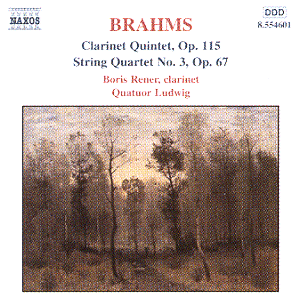The clarinet is very mellow-toned while the strings
offer a more projected style of playing, emphasised by the brightly
forward recording. Also, the tendency of the leader to play fractionally
sharp at times counters with the clarinettist’s tendency to be just
very minimally flat here and there. This would probably matter more
if the performance were of the kind that emphasises the autumnal nature
of the music, but since the performers clearly want to stress that the
ageing composer still had plenty of red blood in his veins the odd rough
edge counts for little. Indeed, if you have a very mellow performance
of the work, you might consider paying the Naxos price just to hear
it differently sometimes.
You might expect the quartet’s approach, on their own,
to be better still for middle-period Brahms but the trouble is that
the Quintet is a masterpiece whereas careful advocacy is needed if the
listener is not to conclude that the "intellectual" medium
of the string quartet drew out the composer’s less gracious qualities.
There is more energy than humanity to the playing and the first violin
tends to dominate too much. The slow movement should not really sound
like a lost movement from a violin concerto and the weakness of the
viola line at bb. 23-4 (and bb. 143-4 of the first movement) suggests
that they have not really delved into the music more than the minimum
indispensable to hold the performance together. I suppose the two violins
and the cello are using mutes as requested in the third movement but
since the fact is not very evident I have to say they fail to exploit
the tone-colour which this implies; there is too much daylight to the
sound. The finale seems more of an andante than an allegretto. I appreciate
that Brahms has indicated some complicated tempo relationships towards
the end and if you start too fast you’ll be in trouble; perhaps with
a little more grace this tempo would have worked. The difference between
andante and allegretto can be one of character as much as of tempo.
Italian words that end in "-etto" and "-ino" always
imply a certain smiling affection. Mahler might not have known this
but Brahms did.
Rather a lot of niggles. This is not one of those Naxos
discs that would go to the top of the list even at full price but it’s
a fair bargain.
Christopher Howell.

